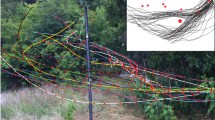Summary
In obstacle avoidance experiments evidence shows that the bat Megaderma lyra uses spatial memory for reorientation. A formula is given for calculating the steadiness St by which a bat continues to pass through a certain position of the mesh-net obstacle. There is a positive correlation between the ability to avoid fixed obstacles and the degree to which a bat makes use of its spatial memory (St). The position of the narrow squares for passing into another room is remembered by an acuracy of 2 cm. Even small obstacles when removed are still remembered for days, and the bats continue to avoid the position of the no more existant obstacles in flight. The position of a frequently used square is well remembered after a training pause of 6 weeks and nearly forgotten after 12 weeks. According to these results it is assumed that in reorientation of bats spatial memory is the most important component.
Zusammenfassung
-
1.
In Gitterhindernisversuchen wird gezeigt, daß Megaderma lyra von 70 identischen Durchflugsquadraten nur wenige benützt und an diesen bestimmten Quadraten über Wochen festhält. Die Lage der bevorzugten Durchflugsquadrate ist für Hin- und Rückflug verschieden.
-
2.
Die Ortsstetigkeit St beim Hindernisdurchflug wird quantitativ bestimmt und nach einer dafür entwickelten Formel berechnet. Die Ortsstetigkeit St ist für Hin- und Rückflug ebenfalls verschieden.
-
3.
Zwischen der Ortsstetigkeit St und der Fähigkeit, eine Kollision mit einem Hindernis zu vermeiden, besteht eine positive Korrelation.
-
4.
In der benützten Versuchsanordnung erinnert sich Megaderma lyra der Lage eines Durchflugquadrates auf 2 cm genau.
-
5.
Nach 6 wöchiger Versuchspause, wird die Lage der zuvor benutzten Quadrate noch gut, nach 12 wöchiger nur noch vage erinnert.
-
6.
In Lichtschrankenversuchen wird gezeigt, daß Megaderma lyra noch 4 Tage lang den Ort eines Drahthindernisses umfliegt, nachdem das Hindernis entfernt worden war.
-
7.
Aus den Versuchen wird geschlossen, daß Megaderma lyra sich bei der Orientierung im bekannten Raum (Wiederorientierung) hauptsächlich auf das genaue Ortsgedächtnis verläßt. Es wird vermutet, daß dies generell für Fledermäuse und andere nächtlich aktive Säuger zutrifft.
Similar content being viewed by others
Literatur
Barbour, R. W., W. H. Davis, and M. D. Hassell: The need of vision in homing by Myotis sodalis. J. Mammal. 47, 356–357 (1966).
Davis, W. H., and R. W. Barbour: The use of vision in flight by the bat Myotis sodalis. Amer. Midld. Naturalist 74, 497–499 (1965).
Möhres, F. P., u. G. Nextweiler: Die Ultraschallorientierung der Großblatt-Fledermäuse (Chiroptera-Megadermatidae). Z. vergl. Physiol. 53, 195–227 (1966).
—, u. Th. Oettingen-Spielberg: Versuche über die Nahorientierung und das Heimfindevermögen der Fledermäuse. Verh. dtsch. zool. Ges. 43, 248–252 (1949).
Pierce, G. W., and D. R. Griffin: Experimental determination of supersonic notes emitted by bats. J. Mammal. 19, 454–455 (1938).
Williams, T. C., J. M. Williams, and D. R. Griffin: The homing ability of the neotropical bat Phyllostomus hastatus, with evidence for visual orientation. Anim. Behav. 14, 468–473 (1966).
Author information
Authors and Affiliations
Rights and permissions
About this article
Cite this article
Neuweiler, G., Möhres, F.P. Die Rolle des Ortsgedächtnisses bei der Orientierung der Großblatt-Fledermaus Megaderma lyra . Z. Vergl. Physiol. 57, 147–171 (1967). https://doi.org/10.1007/BF00303070
Received:
Issue Date:
DOI: https://doi.org/10.1007/BF00303070




